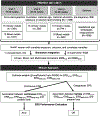Performance of urine, blood, and integrated metal biomarkers in relation to birth outcomes in a mixture setting
- PMID: 34097892
- PMCID: PMC8403638
- DOI: 10.1016/j.envres.2021.111435
Performance of urine, blood, and integrated metal biomarkers in relation to birth outcomes in a mixture setting
Abstract
Background: Studies on the health effects of metal mixtures typically utilize biomarkers measured in a single biological medium, such as blood or urine. However, the ability to evaluate mixture effects are limited by the uncertainty whether a unified medium can fully capture exposure for each metal. Therefore, it is important to compare and assess metal mixtures measured in different media in epidemiology studies.
Objectives: The aim of this study was to examine the mixture predictive performance of urine and blood metal biomarkers and integrated multi-media biomarkers in association with birth outcomes.
Methods: In our analysis of 847 women from the Puerto Rico PROTECT Cohort, we measured 10 essential and non-essential metals in repeated and paired samples of urine and blood during pregnancy. For each metal, we integrated exposure estimates from paired urine and blood biomarkers into multi-media biomarkers (MMBs), using intraclass-correlation coefficient (ICC) and weighted quantile sum (WQS) approaches. Using Ridge regressions, four separate Environmental risk scores (ERSs) for metals in urine, blood, MMBICC, and MMBWQS were computed as a weighted sum of the 10 metal concentrations. We then examined associations between urine, blood, and multi-media biomarker ERSs and birth outcomes using linear and logistic regressions, adjusting for maternal age, maternal education, pre-pregnancy body mass index (BMI), and second-hand smoke exposure. The performance of each ERS was evaluated with continuous and tertile estimates and 95% confidence intervals of the odds ratio of preterm birth using area under the curve (AUC).
Results: Pb was the most important contributor of blood ERS as well as the two integrated multi-media biomarker ERSs. Individuals with high ERS (3rd tertile) showed increased odds of preterm birth compared to individuals with low ERS (1st tertile), with 2.8-fold (95% CI, 1.49 to 5.40) for urine (specific gravity corrected); 3.2- fold (95% CI, 1.68 to 6.25) for blood; 3.9-fold (95% CI, 1.72 to 8.66) for multi-media biomarkers composed using ICC; and 5.2-fold (95% CI, 2.34 to 11.42) for multi-media biomarkers composed using WQS. The four ERSs had comparable predictive performances (AUC ranging from 0.64 to 0.68) when urine is examined with specific gravity corrected concentrations.
Conclusions: Within a practical metal panel, measuring metals in either urine or blood may be an equally good approach to evaluate the metals as a mixture. Applications in practical study design require validation of these methods with other cohorts, larger panels of metals and within the context of other adverse health effects of interest.
Keywords: Manganese; Metals; Prenatal stress; Puerto Rico; Social support.
Copyright © 2021 Elsevier Inc. All rights reserved.
Conflict of interest statement
Conflict of Interest
The authors declare that they have no actual or potential competing financial interest
Declaration of interests
The authors declare that they have no known competing financial interests or personal relationships that could have appeared to influence the work reported in this paper.
Figures






References
-
- Burke T, et al., Human Biomonitoring for Environmental Chemicals. 2006, National Research Council of the National Academies, Washington, DC.
Publication types
MeSH terms
Substances
Grants and funding
LinkOut - more resources
Full Text Sources

